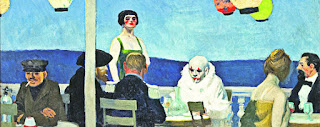The works have been selected. Handlers contracted. Opening parties and after-parties and after-after-parties arranged. It’s almost time for the cultural glitterati to come together and salute each other’s art (and, just as important, artful outfits). Yes, the Armory Show is nearly upon us!
Okay, so there are no gold statues, and no Angelina Jolie, but the Armory Show’s still a pretty big deal around these parts. New York’s foremost art fair has been held annually since 1999, but it has its roots in a show that happened almost a century ago, the Armory Show of 1913. If you took any sort of a modern art class in college, you know all about it: the show that alternately scandalized and sparked imaginations, introducing Americans to some of the most important art and artists of the modern period. (Physics and econ majors, don’t fret: the University of Virginia has a great site with a virtual tour.) Since so many of these works are now widely acclaimed as masterpieces, it’s hard to imagine how revolutionary this art looked at the time (or how reviled; Teddy Roosevelt reportedly declared, “That’s not art!”). But they’re still pretty wonderful to look at. So here, for a rainy Friday, is a look at five works in MoMA’s collection that appeared in the 1913 show (the actual works, or versions thereof).

